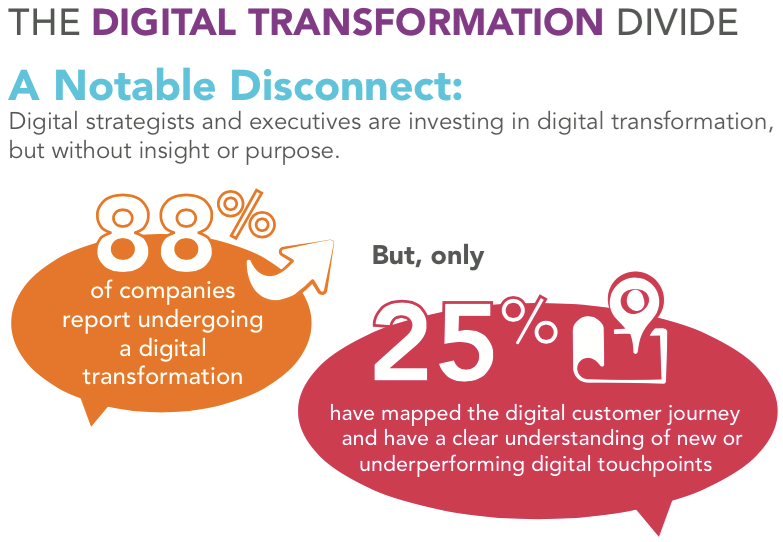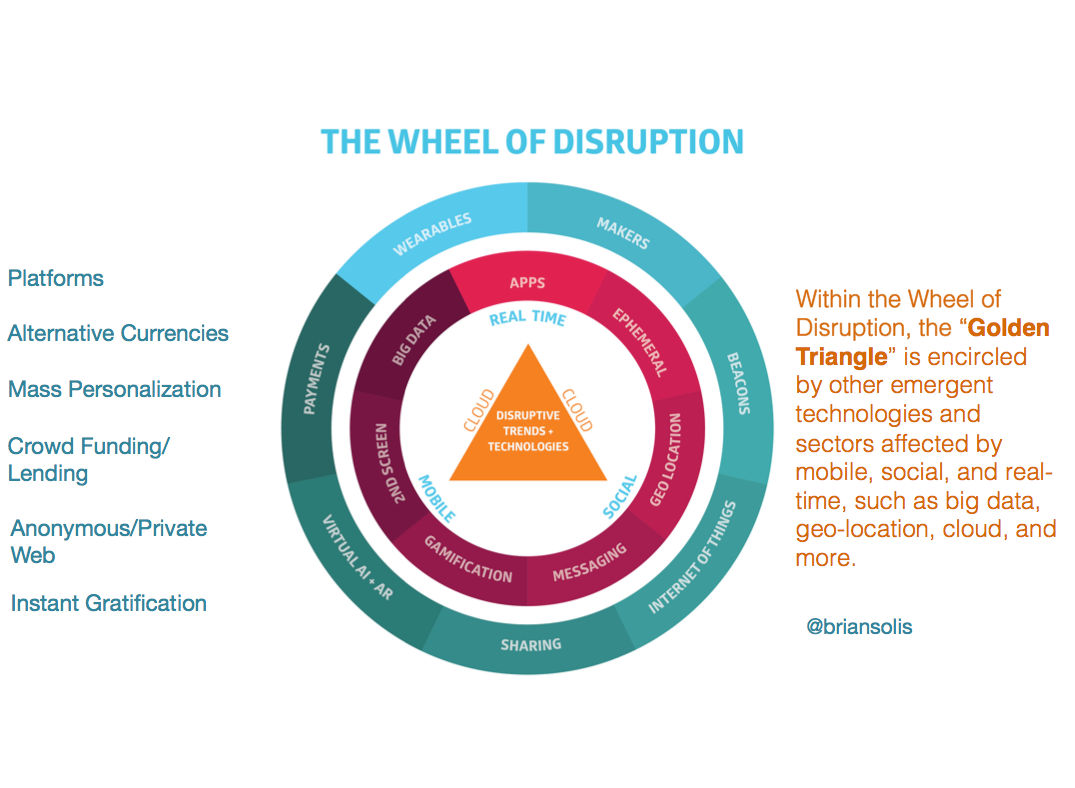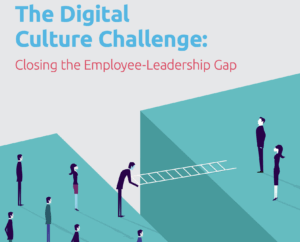When I published the first in a new series of reports exploring the state and future of Digital Transformation, it was almost the antithesis of a typical technology report. It didn’t talk about tech trends for automated marketing. It mentioned zero platforms, software or apps for improving processes, manufacturing or customer or employee engagement. It also didn’t talk about the latest enterprise cloud services to improve marketing or CRM or process big data and the like. Instead, I, along with my Altimeter Group colleagues Jaimy Szymanski and Charlene Li, offered a behind the scenes glimpse to learn about the people who are bringing about change inside of companies and how technology serves an enabler for digital transformation.
As the series of reports were launching, I was interviewed for TechCrunch. Although it did not publish, I did want to share it with you here. I’ve also assembled links to each of the reports.
“Digital Transformation: Why and How Companies are Investing in New Business Models to Lead Digital Customer Experiences” – download.
“The State of Digital Transformation: 2014: How Companies are Investing in the Digital Customer Experience (DCX)” – download.
“The State of Digital Transformation: Infographic” – download
What is Digital Transformation and why is important to startups and businesses?
Digital transformation sounds like one of those buzzwords that might come out of HBO’s Silicon Valley show. Digital Transformation is an emerging, but well-studied movement where companies thoughtfully invest in new technologies and also new processes and business models to compete in a digital age.
Times change and there are many factors influencing how we work and live. Among them, the acceleration of disruptive technologies are impact markets, models and equally affecting behavior. Understanding how and why is only going to help tomorrow’s startups, existing and new enterprise philosophies and operations as well as those struggling today to better excel in these shifting markets. Small and large businesses too need to understand how decision-making is changing, where and what are the new touchpoints, what people value and how it’s different than the past. These insights inform investments and also affect value propositions and everything that supports selling to, catering and supporting a much more connected, and discerning, customer.
It’s part technology but also part social science. Technology is a catalyst for change and also a means for establishing relevance in new markets, but technology alone is not a solution. It reminds me of a quote from Steve Jobs, “…technology alone is not enough — it’s technology married with liberal arts, married with the humanities, that yields us the result that makes our heart sing and nowhere is that more true than in these post-PC devices.”
What makes digital transformation so important now?
Social, mobile, real-time, and other disruptive technologies are aligning like never before to necessitate big changes within organizations, forcing them to adapt in order to maintain relevancy. Digital transformation is significant because it is finally driving real change within businesses; they’re developing new models, team structures, and customer-centered philosophies along the way.
Looking beyond post-PC devices, what digital transformation is really about is the impact of new devices, networks, apps, pervasive internet, et al on you and me, how we knowingly or unknowingly change and what companies need to do to get in front of it. When you take a look at some of the most disruptive and promising technology trends out there right now, you realize just how far we’ve come but also how much more things will change in the next 5,10 years and 20 years ahead.
You’ve studied digital influence and social business in the past, why the move to digital transformation?
Yes. I’ve long studied digital influence, the evolution of social business, among other key trends. At the end of the last social business report I wrote, “The Evolution of Social Business: Six Stages of Social Media Transformation,” I learned that at the far right of business evolution was a state that we referred to as “Converged,” one where previously disparate groups were starting to work with one another to consolidate and optimize customer engagement at every stage of the lifecycle beyond social. It was just the beginning of what many refer to as digital transformation.
Obviously social was just part of the driving force behind change. The real catalyst was behavior. I was fascinated by how the future of business was taking shape right now.
Capgemini, IBM, Econsultancy, among others have published excellent research on the subject. In fact, their research already connects digital transformation with increases in business performance and scale. The more I spoke with the people leading digital transformation, the more I realized that there were processes and strategies for rallying others, especially executives, together around the need to change and how to bring it about.
It all starts with a renewed focus on the customer, the human side of business. This led us to a narrowed focus on digital transformation.
As such, for the purpose of the new report, we defined it as: The re-alignment of, or new investment in, technology and business models to more effectively engage digital consumers at every touchpoint in the customer experience lifecycle.
Our research over the last five years have found that disruption affects customer actions, expectations and values, basically the entire customer journey. Yet, businesses are still making investments in places that are losing alignment with how things are progressing. We’re seeing this play out now in the sharing and maker economies today as governments and incumbent organizations attempt to regulate or squash new competitors. In the end, customers wield great power. Their preferences are merely unlocked or enabled by better services, experiences and real-time technology.
The question is, in the face of disruption from not only new competition, but also customer behavior, what do businesses do differently moving forward?
Are you saying that companies are out of touch with digital customers?
Yes. Even though companies are boosting technology budgets, they’re doing so based on assumptions and not from data or research into the new customer journey. More so, brands don’t yet have the infrastructure to support next-generation marketing efforts. But, there is hope!
We also learned that brands are creating a sense of urgency by using insights stemming from the new digital customer experience (DCX) as the catalyst for internal digital transformation.’
It starts by asking “what would my digital customer do” and then compare that research to investments around the traditional customer of today (or I should say yesterday). Then, digital transformation represents the quest to understand how disruptive technology affects the digital customer experience.
Earlier you said that the people inside these companies inspired you to think differently about digital transformation. Wrap us up by telling us how and why…
Very rarely did we see businesses where senior leadership said, “let’s change to win the digital customer!”
In most cases, digital transformation takes an internal change agent to spark a sense of urgency, gain support, and pave the way for a more formal, collaborative approach to change.
The human side of all of this is about the people in different parts of the company who are pushing for change. They’re fighting politics, egos, skepticism, and uncertainty. They’re on the front lines, in the hallways, in the conference rooms, bringing people together to find ways to not only collaborate but solve for problems and opportunities.
It’s people like Adam Brotman at Starbucks, Bridget Dolan at Sephora, Perry Hewitt at Harvard, Grant Ferguson at Motorola Solutions and Lars Silberbauer at LEGO, among others, who are paving the way forward for digital transformation.
In fact, Lars shared advice for change agents that I wanted to share with you here, “It’s about finding those people in different departments who are willing to risk things to be a lead within the company. There are a lot of people who want to take a company forward.”
Digital transformation isn’t an end goal; it’s a continuous journey. It’s the result of learning more about the relationship between technology and customer behavior to ultimately earn relevance among them.
Connect with me…
Twitter | LinkedIn | Facebook | Youtube | Instagram | Pinterest









I agree entirely that many companies are still struggling to adapt to the digital age, but that puts them three decades behind. We have moved on through the connection era and are now in the machine learning era, when systems learn and continuously adapt.
There is a meme about the solar system going the rounds which is analogous (https://www.youtube.com/watch?v=0jHsq36_NTU). We see the planets rotating around a static sun. But actually the sun is moving at 70,000km/hr. When you visualise this, the planets are moving in a vortex, like water going down a plughole.
Markets move just as fast. Companies orbiting those markets must keep up, not just stand still.
Always appreciate your perspective….
Ditto. Looking forward to more in 2015. Have a good one.
Very interesting article! thanks for sharing.
What about blockchain or bitcoin? Not a good enough article.